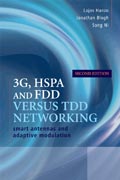
3G, HSPA and FDD versus TDD networking: smart antennas and adaptive modulation
Hanzo, Lajos
Blogh, Jonathan
Ni, Song
INDICE: About the Authors Other Wiley and IEEE Press Books on Related Topics Preface Acknowledgments 1 Third-Generation CDMA Systems 1.1 Introduction 1.2Basic CDMA System 1.3 Third-Generation Systems 1.4 Summary and Conclusions 2 High Speed Down-Link and Up-Link Packet Access 2.1 Introduction 2.2 High SpeedDownlink Packet Access 2.3 High-Speed Uplink Packet Access 2.4 ImplementationIssues 2.5 Glossary 3 HSDPA-Style Burst-by-Burst Adaptive Wireless Transceivers 3.1 Motivation 3.2 Narrowband Burst-by-Burst Adaptive Modulation 3.3 Wideband Burst-by-Burst Adaptive Modulation 3.4 Wideband BbB-AQAM Video Transceivers3.5 BbB-AQAM Performance 3.6 Wideband BbB-AQAM Video Performance 3.7 BbB Adaptive Joint-detection CDMA Video Transceiver 3.8 Subband-Adaptive OFDM Video Transceivers 3.9 Summary and Conclusions 4 Intelligent Antenna Arrays and Beamforming 4.1 Introduction 4.2 Beamforming 4.3 Adaptive Beamforming 4.4 Summary and Conclusions 5 Adaptive Arrays in Cellular Networks 5.1 Introduction 5.2 Modelling Adaptive Antenna Arrays 5.3 Channel Allocation Techniques 5.4 Employing Adaptive Antenna Arrays 5.5 Multipath Propagation Environments 5.6 Network Performance Results 5.7 Summary and Conclusions 6 HSDPA-Style FDD Networking, Adaptive Arrays and AQAM 6.1 Introduction 6.2 Direct Sequence Code Division Multiple Access 6.3 UMTS Terrestrial Radio Access 6.4 Simulation Results 6.5 Summary and Conclusions 7 HSDPA-Style FDD/CDMA Performance Using LS Spreading Codes 7.1 Effects of LS Spreading Codes on the Performance of CDMA Systems 7.2 Effects of Cell Size on the UTRA Performance 7.3 Effects of SINR Threshold on the UTRA Performance 7.4 Network-Layer Performance of Multi-Carrier CDMA 8 HSDPA-Style TDD/CDMA Network Performance 8.1 Introduction 8.2 UMTS FDD Versus TDD Terrestrial Radio Access 8.3 UTRA TDD/CDMA System 8.4 Interference Scenario In TDDCDMA 8.5 Simulation Results 8.6 LS Code Aided Network Performance of UTRA-like TDD/CDMA 9 The Effects of Power Control and Hard Handovers on the UTRA TDD/CDMA System 9.1 A Historical Perspective on Handovers 9.2 Hard Handover in UTRA-like TDD/CDMA Systems 9.3 Power Control in UTRA-like TDD/CDMA Systems 9.4 Summary and Conclusion 10 Genetically Enhanced UTRA/TDD Network Performance 10.1 Introduction 10.2 The Genetically Enhanced UTRA-like TDD/CDMA System 10.3 Simulation Results 10.4 Summary and Conclusion 11 Conclusions and Further Research11.1 Summary of FDD Networking 11.2 Summary of FDD Versus TDD Networking 11.3Further Research Glossary Bibliography Author Index
- ISBN: 978-0-470-75420-7
- Editorial: John Wiley & Sons
- Encuadernacion: Cartoné
- Páginas: 600
- Fecha Publicación: 22/02/2008
- Nº Volúmenes: 1
- Idioma: Inglés
